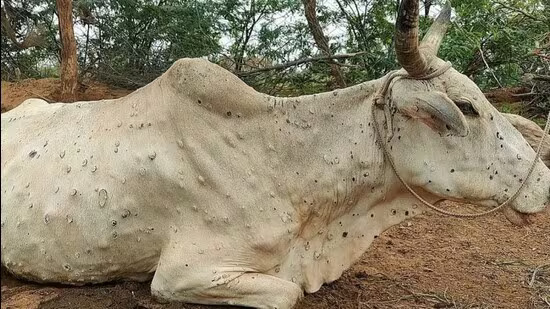The pace of milk production in the country slowed in 2022-23 due to outbreak of the lumpy skin disease among cattle, the Government informed the Lok Sabha on Tuesday.
Replying to a query, Parshottam Rupala, Union Minister for Fisheries, Animal Husbandry and Dairying, said the annual growth rate of milk production in the country came down to 3.83 per cent in 2022-23 from 5.77 per cent in 2021-22.
The lumpy skin disease was the main reason behind the slower growth of milk production in 2022-23, he said.
Referring to the official statistics released by the Food and Agriculture Organisation of the United Nations, he said India maintains the position of the largest producer of milk in the world.
Chilli production
In another written response, Arjun Munda, Union Agriculture and Farmers’ Welfare Minister, said the chilli crop was affected by a new invasive thrips species in 2021-22 crop season. Its infestation caused significant damage to the crop, bringing down the chilli production at national level from 20.49 lt in 2020-21 to 18.36 lt in 2021-22, he said.
The infestation was severe in Andhra Pradesh where the production had gone down to 4.18 lt in 2021-22 from 7.97 lt recorded previous year. The productivity of chilli in Andhra Pradesh plummeted to 1.86 tonnes per hectare in 2021-22 from an average annual productivity of 4-5 tonnes per hectare.
According to the reply, India’s chilli production was at 20.59 lt (second advance estimate) during 2022-23.
Nano urea plants
Replying to a separate question on nano urea plants in the country, Munda said IFFCO has set up three nano urea plants at Kalol in Gujarat, and Phulpur and Aonla in Uttar Pradesh with total production capacity of 17 crore bottles (500 ml) per annum.
Ray Nano Science and Research Centre has also declared commercial production of its nano urea plant at Anand in Gujarat having capacity of 4.5 crore bottles per annum, he said.
Referring to nano urea trials by research institutes of Indian Council of Agricultural Research (ICAR) and state agricultural universities on crops such as paddy, wheat, mustard, maize, tomato, cabbage, cucumber, capsicum and onion in different agro-climatic zones, he said nano urea can be used as foliar spray for top-dressing instead of normal urea. Foliar application of nano urea, along with basal application of recommended dose of urea, has yield advantage of 3-8 per cent over conventional fertiliser application, he said.
3,499 vacancies in KVK
To a separate query on the vacancies in Krishi Vigyan Kendras (KVKs) in the country, Munda said KVKs are opened under the administrative control of the different host organisations such as State government, Central agricultural universities, State agricultural universities, public sector undertakings, non-governmental organisations and ICAR.
Stating that there are certain vacancies in KVKs, he said filling up of the vacancies in KVKs is the responsibility of the host organisation concerned, and ICAR regularly follows up with them.
According to the reply, 638 districts in the country have KVKs. There were 3,499 vacancies in KVKs in the country.
Source: The Hindu Businessline







